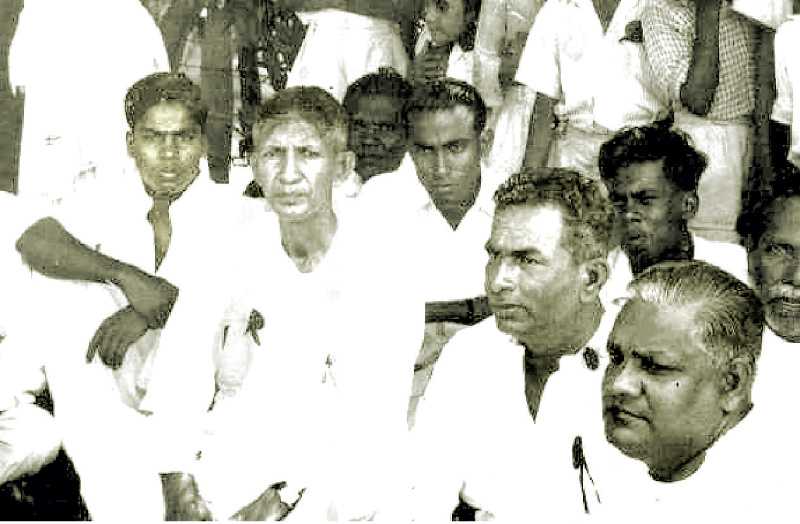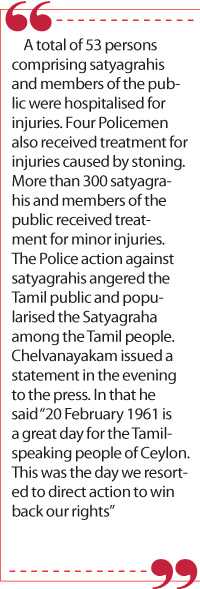Monday Dec 29, 2025
Monday Dec 29, 2025
Thursday, 18 February 2021 00:37 - - {{hitsCtrl.values.hits}}

S.J.V. Chelvanayakam at a Satyagraha
 20 February 1961 is a very important date in the history of the Sri Lankan Tamil political struggle to regain lost rights.
20 February 1961 is a very important date in the history of the Sri Lankan Tamil political struggle to regain lost rights.
It was on this day 60 years ago that the Ilankai Thamil Arasu Katchi (ITAK) known in English as the Federal Party (FP) led by S.J.V. Chelvanayakam commenced a non-violent direct action campaign against the Sri Lanka Freedom Party (SLFP) Government headed by the world’s first woman Prime Minister Sirima Bandaranaike. This column intends re-visiting the hectic events amounting to a ‘baptism of fire’ on that fateful day in February 60 years ago.
The SLFP formed a Government under Prime Minister Sirimavo Bandaranaike in July 1960. The new Government embarked upon a project of ‘total Sinhalaisation’ of the Administrative and Judicial spheres. Sinhala would be implemented as the sole Official Language in all areas of administration. The Government also intended passing legislation making Sinhala the language of courts in all parts of the island. This increased insecurity among the Tamil people about their political future.
The ITAK/FP was now under tremendous pressure from its Tamil constituency to do something in this regard. The Tamil leaders tried to resolve the issue through negotiations and two rounds of discussions were held with the Government. The talks however collapsed due to a variety of reasons. The ITAK/FP action committee met on 8 January 1961 and decided to conduct a widespread ‘Satyagraha’ campaign in the north and east before 20 February 1961.
Satyagraha strategy
The strategy for the Satyagraha was devised by former Kayts MP and Party Secretary V. Navaratnam, described as the “Thanga Moolai” (Golden Brain) of the ITAK/FP. The modus operandi of the protest was for batches of dedicated volunteers to sit in front of the entrances to the Kachcheris or administrative secretariats of districts. They would prevent Government employees from working by blocking them.
The campaign would commence in Jaffna. Thereafter it would be conducted in Batticaloa, Trincomalee, Mannar and Vavuniya. At that time the Amparai, Mullaitivu and Kilinochchi Districts had not been demarcated. The ultimate objective was to paralyse civil administration in the north and east through non-violent action
After much preparatory activity, the ITAK was ready to launch its Satyagraha. A lengthy statement issued on 19 February by Party Leader S.J.V. Chelvanayakam set out the parameters of the Satyagraha campaign.
 D-day
D-day
D-day dawned on 20 February 1961. The first batch of Satyagraha volunteers all from the Kankesanthurai electorate represented by S.J.V. Chelvanayakam converged at the FP office at No. 25, 2nd Cross Street, Jaffna. The non-violent contingent then started out in a procession towards the Jaffna Kachcheri situated along the Jaffna-Kandy A-9 highway.
Chelvanayakam dressed in verti and salvia was at the head of the group. The satyagrahis reached the Kachcheri premises and took up positions in front of the entrances to the Kachcheri. The time was 7:30 a.m.
It must be noted that the Jaffna Kachcheri was not housed then in the present building where it is situated now. The old Kachcheri was situated in the large grounds known as Old Park. The main entrance to the Kachcheri was on the Jaffna-Kandy Road. The official residence of the Jaffna District Government Agent was also within the Old Park. Known as the Old Park Residency it had another separate entrance along the Jaffna-Kandy Road. There was a third, largely-unused smaller gate on the other side of Old Park along Old Park Road.
The satyagrahis led by Chelvanayakam sat on the ground opposite both the Kachcheri main entrance and entrance to the residency. The objective was to block Government servants from entering their office premises and working. Apart from the volunteers from the KKS constituency, smaller groups of volunteers from other constituencies also assembled with their members of Parliament. Some of these MPs sat along with Chelvanayakam on the first row of satyagrahis.
Amirthalingam’s wife Mangaiyatkarasi Amirthalingam along with some women volunteers sat behind the frontline leaders in the second row. Mangaiyatkarasi being a reputed singer conducted ‘bhajans’ where the lead singer chants the lines first and is followed in chorus by the rest. In keeping with the prevailing Gandhian ethos, she started off with ‘Ragupathy Raghava Raja Ram,’ a favourite of the Mahatma.
There were about 200 accredited satyagrahi volunteers with official badges at the Kachcheri venue. Satyagrahi volunteers dressed in white began peacefully approaching the Kachcheri employees when they arrived for duty. The volunteers told them of their campaign and entreated them as Tamils not to go in and start work. There were more than 250 employees of all grades at the Kachcheri. Most of them adhered to the Satyagrahi request and did not go in. They gathered in a large group and watched proceedings as bystanders.
Many members of the public also began arriving to transact official business at their Kachcheri. Again satyagrahi volunteers accosted them and fervently urged them not to go in. Almost all complied with the plea. They too began waiting and watching to see what was happening. Meanwhile a large crowd was gathering at the venue. Some were curious onlookers but most pf them were sympathetic spectators. A large number consisted of youths.
Police arrive
It was at 8:45 a.m. that the Police arrived ‘officially’ at the scene although some cops in civil attire had been quiet observers for quite a while. The Jaffna Superintendent of Police then was Richard Arndt. The Assistant Superintendent of Police was Arumugam Mahendran. Both arrived on the spot in separate jeeps.
The senior Police officials were accompanied by a very large party of Policemen who arrived in trucks, vans and jeeps. Many of them wore helmets and carried shields. Jaffna had not witnessed so many Policemen in anti-riot gear before. They also had batons which they ‘showed off’ by brandishing them before the public and satyagrahis.The Policemen took up positions and awaited orders. The Police Superintendent Richard Arndt ordered the Police to clear the main entrance to the Kachcheri by removing the satyagrahis. It appeared that SP Arndt had no intention of arresting anyone. He wanted the satyagrahis to be dragged out and dumped forcefully. None were to be arrested.
Arndt sent word to the ITAK leaders through ASP Mahendran that they should stop blocking the main entrance to the Kachcheri so that Government employees could enter. If they refused the Police would clear the area by force. Dr. Naganathan and Amirthalingam then walked up to the Jaffna Superintendent’s jeep and informed Arndt that they would not allow Government employees to enter Kachcheri premises. As such they could not clear the way. The SP then said he would give them five minutes to disperse. Otherwise the Police would remove the satyagrahis through force.
The FP leaders were concerned about the fragile vulnerability of their esteemed and beloved leader. They requested Chelvanayakam to move out from the place. When Chelvanayakam refused, the women present led by Mangaiyatkarasi Amirthalingam implored him tearfully to leave. Chelvanayakam reluctantly left with some of the women volunteers.
A team of satyagrahis led by the then Kayts MP VA Kandiah, a lawyer himself, changed positions and sat with their backs to the entrance. The others sat in rows facing the entrance. The satyagrahis realised that the Police were going to use force and bodily remove them. But they sat there unflinchingly armed only with their love of their mother tongue and belief in the doctrine of non-violence.
 Police action
Police action
When the five minutes ‘grace’ was over Richard Arndt ordered Police action. When the SP ordered that the satyagrahis be removed bodily instead of being arrested, even the Police at the scene appeared bewildered and hesitant. Losing his cool, Arndt yelled at his Chief Lieutenant ASP Mahendran to “drag these buggers out by their hands and legs”.
Spurred by Arndt’s outburst the Police stirred themselves and moved in. They began lifting the satyagrahis one by one and carried them to a distance and threw them on the ground. But even as they were thrown the satyagrahis led by Kandiah picked themselves up and hurried back to their places and resumed their unarmed struggle. While this was going on other satyagrahis moved in and sat blocking the entrance.
Soon the Police began losing patience and started dragging the Satyagrahis away instead of carrying them. This too did not deter the protestors who kept on blocking the entrance. Some began to lie flat on the ground. Some policemen then began to roll the prostrate Satyagrahis. A few blows and kicks were delivered. But the satyagrahis did not retaliate.
After about 15 minutes Arndt ordered the Police to stop. He now altered his course of action. The Northern Police Superintendent instructed Policemen to form two columns on both sides of the path leading to the main entrance. Soon the Police were standing in two lines towering above the seated satyagrahis. A narrow path straddled by cops on either side had evolved.
Arndt then went up to the Kachcheri employees huddled in groups and ordered them to walk through the narrow route between satyagrahis. While most Government servants hesitated, a few encouraged by the SP and ASP started walking towards the entrance. It appeared that the ‘cordon’ of the satyagrahis was about to be breached.
But the hour brings forth the man! A comparatively young Bharatha Tamil from Chilaw was also a participant in the Satyagraha. He was none other than Francis Pereira who had contested Chilaw on the FP ticket in the July 1960 elections and came third obtaining 2,278 votes.
Instead of sitting passively and letting the Government officials pass through, Francis Pereira threw himself on the ground in front of the advancing officials. Motivated by this act of non-violent defiance, other volunteers too started prostrating themselves on the ground thus impeding the progress of Government employees.
Police violence
An enraged Arndt then blasted his subordinates and commanded them to break up the Satyagraha and let the Government servants move inside. Now the cops got cracking again – literally and metaphorically. A barrage of baton blows were directed at the satyagrahis but they remained firmly glued to the ground despite the rain of blows. The Police in a frenzied exhibition of brute force began to kick and stomp on satyagrahis.
In a desperate effort to clear the way the Police also started to pull, drag and carry away the satyagrahis. A very high degree of force was employed this time. Some volunteers were lifted up from their positions and thrown down elsewhere like inanimate objects in a rough, haphazard manner. Others were dragged away by their hands and legs over rough terrain. Some others were pulled out and pushed forcibly on the ground. Despite this display of brute force against unarmed protestors the satyagrahis were unrelenting.
The hero in that melee was Francis Pereira, the Cheetah from Chilaw. He would be dragged out by the Police but would immediately return and throw himself down on the ground. He would again be pulled out and hurled down but would return again. According to eye-witness accounts of veteran satyagrahis, Francis Pereira would have done so at least about 15 times. His shirt and trousers were torn and in rags but the man remained firm, unbowed and unafraid. Inspired by Francis Pereira, the satyagrahis continued to block the main entrance in spite of tremendous Police pressure.
The situation was tense and emotional. Seeing the pathetic plight of the satyagrahis, sections of the Tamil spectators and bystanders were emotionally aroused and got agitated. In an unexpected turn of events members of the crowd began to rush in spontaneously and squat opposite the main entrance. A few were hit by the cops but did not run away. It soon became apparent that the Satyagraha of a few was transforming into mass action by many.
After a long tussle the Police called it quits. The time was around 10:15 a.m. Arndt ordered the Police to cease action. He then drove into the Old Park again and went into the GA’s residence.
Meanwhile the ITAK/FP leaders thanked the members of the public for their support and gently persuaded them to retire, saying the registered volunteers would continue with the Satyagraha. While injured and hurt satyagrahis went away from the scene for medical treatment, others took up positions again.
20 February
The drama however was not over; 20 February was the date on which the Assize sessions of the Supreme Court were scheduled to open in Jaffna. The Jaffna GA M. Sri Kantha was required to be present for the Assize session opening as he had to present the mandate in his capacity as fiscal marshal. The opening was to be at 11 a.m.
The satyagrahis on their watch were taken by surprise when the GA Mr. Sri Kantha came out of the residency at 10:30 a.m. with the SP Richard Arndt and clambered aboard the Police jeep. The jeep then proceeded to the Old Park residency entrance on the Jaffna-Kandy Road instead of the main entrance.
As stated earlier the Old Park entrance had only a small presence of satyagrahis numbering 25. When they saw the GA trying to exit in the Police jeep they promptly threw themselves down on the ground in front of the entrance. The jeep had to screech to a halt because a youth in his early twenties named Palaniappan threw himself in front of the jeep. The front wheel was only a few feet from him when the vehicle braked suddenly.
Arndt then bellowed to the Police to throw the “buggers” out and clear passage. The Police promptly obeyed his orders. It was only then that the ruse adopted by Arndt came to light. The Old Park entrance precincts were packed with more than 75 policemen. Arndt had cleverly infiltrated the area with cops without the satyagrahis noticing it. With the ratio of Policemen to satyagrahis being more than three to one, the cops found it easy to clear the way unlike at the Kachcheri main entrance.
Alerted to the fracas at the Old Park entrance many of the satyagrahis at the main entrance came rushing. At the forefront were five Tamil MPs, namely Naganathan, Kandiah, Amirthalingam, Dharmalingam and Thurairatnam.
V.A. Kandiah went right up to the jeep and sat across with his back to the radiator. Naganathan and Amirthalingam sat in front of the jeep while Dharmalingam and Thurairatnam prostrated themselves on the ground. Despite this high-level attempt to thwart the GA’s departure, the numerical strength of the Police contingent made it ‘mission impossible’. Kandiah was carried out and dumped on the ground. Thurairatnam and Dharmalingam were dragged out by their hands and legs. Naganathan and Amirthalingam were baton charged.
It was then that an unusual incident occurred. When a policeman rained blows on Dr. Naganathan – known for his pugnacious nature and pugilistic skills – he grasped one end of the baton to prevent being hit. There was a tug of war with both the MP and cop pulling the baton. In the tussle the baton suddenly broke in two with each adversary holding on to one part. Later Naganathan was to take the broken baton piece home as a souvenir.
Although the ‘battle of the baton’ violated the principle of Satyagraha, the incident created a popular image for Naganathan among Tamils. He was eulogised as “Irumbu Manithan” or ‘Iron Man’ thereafter because the baton broke during the assault.
Violence erupts
Despite these efforts by the satyagrahis the Jeep with the GA and SP managed to drive out through a gap created by the Police. Seeing the jeep drive away a section of the public (not accredited satyagrahis) infuriated by the escape pelted a few stones at the vehicle. The windscreen cracked as a result.
Angered by the stone throwing the Police now turned on the public and began a baton charge. By that a time a crowd of about 5,000 had gathered at the spot and in the vicinity. These were ordinary citizens who had heard about the Police brutality and had converged in solidarity at the scene. These were not satyagrahis trained to refrain from violence. Some of these members of the public began to throw stones at the Police. The Police retaliated by assaulting them. The Police also surprised the public by producing sacks full of stones and throwing them at the people.
With the crowds becoming increasingly volatile the Police resorted to firing in the air thrice and firing tear gas canisters once. The situation began to turn ugly. With passions being aroused there was the danger of the non-violent Satyagraha turning into a violent skirmish. The FP leaders appealed to the crowds to disperse peacefully. Slowly the crowds diminished. The tense climate eased. At 1:30 p.m. the Satyagraha was called off on the first day.
A total of 53 persons comprising satyagrahis and members of the public were hospitalised for injuries. Four Policemen also received treatment for injuries caused by stoning. More than 300 satyagrahis and members of the public received treatment for minor injuries. The Police action against satyagrahis angered the Tamil public and popularised the Satyagraha among the Tamil people
Chelvanayakam issued a statement in the evening to the press. In that he said “20 February 1961 is a great day for the Tamil-speaking people of Ceylon. This was the day we resorted to direct action to win back our rights.”
This then was the story of the first day of the 1961 Satyagraha and its baptism of fire.
(D.B.S. Jeyaraj can be reached at [email protected])